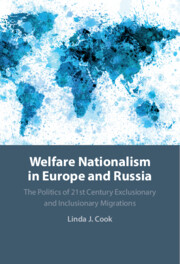 Welfare Nationalism in Europe and Russia
Welfare Nationalism in Europe and Russia Authoritarian Politics of Exclusion
from Part III - Exclusionary Migrations
Published online by Cambridge University Press: 14 November 2024
Chapter 4 focuses on labor migration from Central Asia to Russia as the first exclusionary migration cycle. Growing migration after 2000 made Russia one of the world’s major migrant-receiving states. The chapter explains why Putin retained a visa-free regime with the much poorer former Soviet states of CA, allowing millions of their citizens free entry to Russia, where most stayed and worked with undocumented status. As the numbers of the ethnically distant Muslim migrants rose, welfare nationalist grievances emerged in the cities and regions where migrants were concentrated. Citing public opinion surveys, speeches by mayors and governors, election and party platforms, and mass media, the chapter shows how politicians framed and used welfare nationalist discourses to placate citizens and scapegoat migrants for declines in popular welfare. It highlights the role of sub-national officials in mobilizing anti-immigrant politics and channeling pressures for exclusionary policies to Putin. These pressures produced legislative and normative changes that progressively excluded migrant families from social sectors and subjected workers to increasing abuses, including deportations and other forms of exclusion. A sub-set of migrants who contributed to Russia’s national security were treated as more deserving.
To save this book to your Kindle, first ensure [email protected] is added to your Approved Personal Document E-mail List under your Personal Document Settings on the Manage Your Content and Devices page of your Amazon account. Then enter the ‘name’ part of your Kindle email address below. Find out more about saving to your Kindle.
Note you can select to save to either the @free.kindle.com or @kindle.com variations. ‘@free.kindle.com’ emails are free but can only be saved to your device when it is connected to wi-fi. ‘@kindle.com’ emails can be delivered even when you are not connected to wi-fi, but note that service fees apply.
Find out more about the Kindle Personal Document Service.
To save content items to your account, please confirm that you agree to abide by our usage policies. If this is the first time you use this feature, you will be asked to authorise Cambridge Core to connect with your account. Find out more about saving content to Dropbox.
To save content items to your account, please confirm that you agree to abide by our usage policies. If this is the first time you use this feature, you will be asked to authorise Cambridge Core to connect with your account. Find out more about saving content to Google Drive.